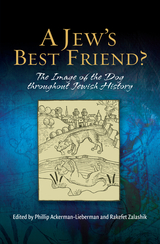 A Jew's Best Friend?: The Image of the Dog Throughout Jewish History
Edited by Phillip Ackerman-Lieberman and Rakefet Zalashik
Sussex Academic Press, 2022 From antiquity to the contemporary period, the dog has captured the Jewish imagination. In medieval Christendom, the image of the dog was often used to characterize and demean Jewish populations. In the interwar period, dogs were still considered goyishe nakhes ("a gentile pleasure") and virtually unheard of in the Jewish homes of the shtetl. Yet, 'Azit the paratrooping dog of modern Israeli cinema, one of many examples of dogs as heroes of the Zionist narrative, demonstrates that the dog has captured the contemporary Jewish imagination. This book discusses specific cultural manifestations of the relationship between dogs and Jews, from ancient times to the present. Covering a geographical range extending from the Middle East through Europe and to North America, the book's contributors provide a unique cross-cultural, trans-national, diachronic perspective. An important theme in the book is the constant tension between domination/control and partnership which underpins the relationship of humans to animals, as well as the connection between Jewish societies and their broader host cultures.
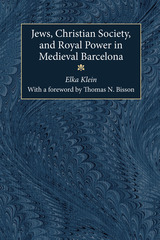 Jews, Christian Society, and Royal Power in Medieval Barcelona
Elka Klein
University of Michigan Press, 2006
Jews, Christian Society, and Royal Power in Medieval Barcelona traces the development of the Jewish community of Barcelona from 1050 to 1300. Elka Klein challenges the common perception that medieval Jews lived in relative isolation from the surrounding society, argues for the existence of significant cultural common ground between Jews and Christians, and proposes a new model for understanding Jewish communal autonomy and the relationship between Jews and their rulers.
Klein traces the development of the Jewish community of Barcelona in two contexts: the parallel development of the city of Barcelona and the changing relationship of the king to urban communities, Jewish and Christian. Until the later twelfth century, the Jewish community, like the Christian city of Barcelona, was left mostly to its own devices by the counts of Barcelona, who had neither the interest nor the power to interfere in internal affairs. Klein draws on both Hebrew and Latin sources to offer a picture of a communal elite whose power, mostly informal, derived from their influence within the community. This system changed in the later twelfth century as a result of the expansion of comitial-royal administration. Four Jewish families used their positions as bailiffs, accountants, and secretaries to consolidate power within their community. The rule of this courtier elite was short lived; two episodes of communal conflict in the early thirteenth century and increased royal activism led to the institution of a new regime of elected officials in 1241. The book concludes with an examination of the new elite and the implications of increased royal interference in internal affairs.
A central argument of Jews, Christian Society, and Royal Power in Medieval Barcelona is that it is necessary to distinguish between autonomy by default, resulting from the indifference of the ruler, who leaves a community to govern itself; and autonomy by design, guaranteed by selective royal interference. Against the view that royal interference undercut Jewish autonomy, Klein argues that autonomy by default left the community with insufficient power to enforce its decisions; because Catalan kings generally interfered in support of existing structures, autonomy by design in fact strengthened the community.
This book contributes to ongoing debates about the relationship between the cultures of the three religions in the Iberian peninsula. It joins a body of recent scholarship arguing that medieval European Jews and Christians shared considerable cultural common ground.
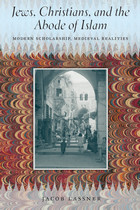 Jews, Christians, and the Abode of Islam: Modern Scholarship, Medieval Realities
Jacob Lassner
University of Chicago Press, 2012 In Jews, Christians, and the Abode of Islam, Jacob Lassner examines the triangular relationship that during the Middle Ages defined—and continues to define today—the political and cultural interaction among the three Abrahamic faiths. Lassner looks closely at the debates occasioned by modern Western scholarship on Islam to throw new light on the social and political status of medieval Jews and Christians in various Islamic lands from the seventh to the thirteenth century. Utilizing a vast array of primary sources, Lassner balances the rhetoric of literary and legal texts from the Middle Ages with other, newly discovered medieval sources that describe life as it was actually lived among the three faith communities. Lassner shows just what medieval Muslims meant when they spoke of tolerance, and how that abstract concept played out at different times and places in the real world of Christian and Jewish communities under Islamic rule. Finally, he considers what a more informed picture of the relationship among the Abrahamic faiths in the medieval Islamic world might mean for modern scholarship on medieval Islamic civilization and, not the least, for the highly contentious global environment of today.
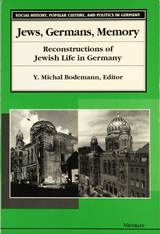 Jews, Germans, Memory: Reconstructions of Jewish Life in Germany
Y. Michal Bodemann, Editor
University of Michigan Press, 1996 How was it possible that a new and sizeable Jewish community developed after the Holocaust in Germany of all places? Jews, Germans, Memory undertakes to assess the past, present, and future of German-Jewish relations in the light of recent political changes and the opening up of historical resources. This welcome new volume investigates how the groundwork was laid for the new Jewish community in the post-war period, with different objectives by Jewish leaders and German politicians. Its contributors touch upon history, literature, the media, ethnicity, politics, and social movements, and attempt to answer the question of how Jews are socially constructed and how the glorious German Jewish past and the Holocaust have been remembered in the course of recent decades. In recent years, German Jewry has seen fundamental transformations with the influx from Eastern Europe and a new leadership in the community. A new self-definition, even self-assurance and reappraisal in Israel and elsewhere, has evolved. Historians, scholars of cultural studies, and those interested in debates on memory and ethnicity will all find something of interest in this diverse volume. Jews, Germans, Memory joins in debate Michael Brenner, Micha Brumlik, Dan Diner, Cilly Kugelmann, and Martin Löw-Beer, among the most prominent younger Jewish intellectuals in Germany today, with others who have long observed Germany from both inside and outside: Y. Michal Bodemann, John Borneman, Andrei Markovits, Robin Ostrow, Moishe Postone, Frank Stern, and Jack Zipes. Y. Michal Bodemann is Professor of Sociology, University of Toronto.
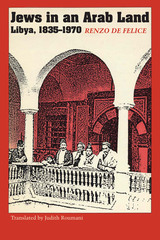 Jews in an Arab Land: Libya, 1835–1970
By Renzo De Felice; translated by Judith Roumani; foreword by Rafello Fellah
University of Texas Press, 1985 Internationally renowned scholar Renzo De Felice’s pioneering study of the Jews of Libya is, in many ways, a microcosm of the major sources of conflict in the modern Middle East. This is the first English translation of Ebrei in un paese arabo, originally published by Il Mulino, Bologna, in 1978. The author’s broad-ranging and meticulous research has enabled him to reconstruct the contemporary history of the Jews in Libya with an incredible richness of detail, bringing into vivid relief the social, religious, cultural, and political lives of a people caught between centuries of tradition and a series of governments bent on plunging them headfirst into the modern world. This story—fraught with the passion, drama, tragicomedy, and conflict of a society in transition—will be an invaluable resource for scholars in Middle Eastern studies, Jewish studies, and contemporary European history. The wealth of documentation, much of it previously unknown or unpublished, makes this a particularly useful book.
The Jews in Late Antiquity
Rodrigo Laham Cohen
Arc Humanities Press, 2018 The lack of source material makes it challenging, but this short book uses the available evidence to present facts and debates around Jews in late antiquity and to provide a first step towards the understanding of this little-known period in Jewish history. It focuses on seven different regions: Italy, North Africa (except Egypt), Gaul, Spain, Egypt, the Land of Israel, and Babylonia.
Jews in Michigan
Judith Levin Cantor
Michigan State University Press, 2001 Since the earliest days of the British fur trade, Jewish pioneers have made Michigan their home. Judith Levin Cantor's Jews in Michigan captures the struggles and triumphs of Michigan's Jews as they worked to establish farms, businesses and synagogues, sparking commercial and residential development throughout the state, and even into the far reaches of the Upper Peninsula. Cantor celebrates both urban and rural immigrants, who supplied essential goods and services to those in lumbering, mining, and automobile manufacturing. She also deals honestly with questions of anti-Semitism and prejudice. Cantor's book shows how, in the quest to build strong communities, Jewish residents also helped create the foundations of the Michigan we know today.
The Jews in Mussolini's Italy: From Equality to Persecution
Michele Sarfatti; Translated by John and Anne C. Tedeschi
University of Wisconsin Press, 2006 Often overshadowed by the persecution of Jews in Germany, the treatment of Jews in fascist Italy comes into sharp focus in this volume by Italian historian Michele Sarfatti. Using thorough and careful statistical evidence to document how the Italian social climate changed from relatively just to irredeemably prejudicial, Sarfatti begins with a history of Italian Jews in the decades before fascism—when Jews were fully integrated into Italian national life—and provides a deft and comprehensive history from fascism’s rise in 1922 to its defeat in 1945. Outstanding Academic Title, Choice Magazine
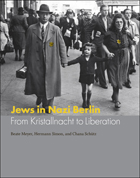 Jews in Nazi Berlin: From Kristallnacht to Liberation
Edited by Beate Meyer, Hermann Simon, and Chana Schütz
University of Chicago Press, 2009 Though many of the details of Jewish life under Hitler are familiar, historical accounts rarely afford us a real sense of what it was like for Jews and their families to live in the shadow of Nazi Germany’s oppressive racial laws and growing violence. With Jews in Nazi Berlin, those individual lives—and the constant struggle they required—come fully into focus, and the result is an unprecedented and deeply moving portrait of a people. Drawing on a remarkably rich archive that includes photographs, objects, official documents, and personal papers, the editors of Jews in Nazi Berlin have assembled a multifaceted picture of Jewish daily life in the Nazi capital during the height of the regime’s power. The book’s essays and images are divided into thematic sections, each representing a different aspect of the experience of Jews in Berlin, covering such topics as emigration, the yellow star, Zionism, deportation, betrayal, survival, and more. To supplement—and, importantly, to humanize—the comprehensive documentary evidence, the editors draw on an extensive series of interviews with survivors of the Nazi persecution, who present gripping first-person accounts of the innovation, subterfuge, resilience, and luck required to negotiate the increasing brutality of the regime. A stunning reconstruction of a storied community as it faced destruction, Jews in Nazi Berlin renders that loss with a startling immediacy that will make it an essential part of our continuing attempts to understand World War II and the Holocaust.
Jews in Nevada: A History
John P. Marschall
University of Nevada Press, 2011 Jews have always been one of Nevada’s most active and influential ethnic minorities. They were among the state’s earliest Euro-American settlers, and from the beginning they have been involved in every area of the state’s life as businessmen, agrarians, scholars, educators, artists, politicians, and civic, professional, and religious leaders. Jews in Nevada is an engaging, multilayered chronicle of their lives and contributions to the state. Here are absorbing accounts of individuals and families who helped to settle and develop the state, as well as thoughtful analyses of larger issues, such as the reasons Jews came to Nevada in the first place, how they created homes and interacted with non-Jews, and how they preserved their religious and cultural traditions as a small minority in a sparsely populated region.
Jews in Old Rus’: A Documentary History
Alexander Kulik
Harvard University Press For the first time, this collection makes available a selection of documents on the history of Jews in old Rus’ that provide unique insight into Slavic–Jewish relations, offering both the original texts in Latin, Hebrew, Church Slavonic, and Arabic, and their English translations.
Adding nuance to our understanding of the difficult relations Rus’ had with Khazaria, Jews in Old Rus’ also realigns the position of East European Jews within the larger diaspora of European Jews. This collection meticulously presents legal rulings, religious and liturgical customs, practices regarding food and garments, linguistic acculturation, and the political loyalties of Jews in old Rus’.
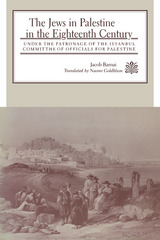 The Jews in Palestine in the Eighteenth Century: Under the Patronage of the Istanbul committee of Officials for Palestine
Jacob Barnai
University of Alabama Press, 1992 Research reveals a clear connection between the legal and social status of the Jews in Palestine in the 18th century and their ties with the Diaspora. The Jews who had immigrated to Palestine in that period were mostly poor and elderly. The country was economically backward and politically unstable, which made it impossible for the immigrants to support themselves through productive work. Therefore they lived off the contributions of their brethren overseas. Taxes and fees imposed by the Ottoman rulers increased the financial desperation of the Jews in Palestine. Prohibitions against young unmarried immigrant men and women made for an unstable population largely of old men, many of whom died shortly after immigrating. Families succumbed to disease, earthquakes, and famine, but in the face of these problems, the Jewish communities in Palestine persevered. When financial support ceased at the beginning of the 18th century, it caused a sever crisis in the Yishuv (the Jewish settlement in Palestine). The Jews were unable to repay their debts to the Moslems, and many left the country. In 1726, a central organization was established in Istanbul to coordinate the Diaspora financial support of the Jews in Palestine. This Istanbul Committee of Officials oversaw the collection of support money for the Yishuv, managed the Palestine community’s budget, established regulations for governing the communities, and settled disputes between the Jews and the gentiles. The importance of the Yishuv in the spiritual life of the Diaspora alone could not ensure the continuation of the Istanbul Officials was crucial. Fortunately, a registry containing copies of 500 letters written by the Istanbul Committee in the mid-18th century was preserved in the archives of the Jewish Theological Seminary. These letters reveal the extensive activity involving the Istanbul Committee and the Ottoman authorities, the Jews of Palestine, and the Diaspora. In this English translation of the original 1982 volume published in Hebrew, Barnai has updated his research to take into account recent scholarship. He concludes that during the period under review, the number of Jews in the Yishuv was actually very small, but they were completely dependent upon the charitable financial support of their brethren overseas, as well as the goodwill of the country’s rulers.
The Jews in Polish Culture
Aleksander Hertz
Northwestern University Press, 1988 Jews in Polish Culture was and in large measure remains an essentially pioneering work. Despite the passage of many years, the book's thrust has retained its initial, original freshness.
 Jews in the Center: Conservative Synagogues and Their Members
Wertheimer, Jack
Rutgers University Press, 2002
Why do well-educated, highly Americanized, and financially secure Jews join a synagogue and participate in its religious life? This study of Conservative Jews examines the largest movement of synagogue-affiliated Jews in the United States, a group that outnumbers the combined membership of Reform and Orthodox congregations and a population that adheres to a centrist version of Judaism. The scholars who contribute to this study ask a series of provocative questions: How do these Jews negotiate the tensions between the traditional values of their religion and modern sensibilities? What meaning do they find in synagogue participation? How crucial are rabbis in the "success" of congregations?
Written by a team of scholars employing the tools of demography, ethnography, sociology, history, and comparative religious studies, Jews in the Center offers the most comprehensive view of any religious movement within American Judaism----and indeed, one of the most detailed studies of any denomination in American religious life.
Jews in the Center seeks to understand how synagogues function as congregations and to what extent they allow for individual self-expression. By focusing on a mainstream population, this book sheds light on religious people who generally receive the least attention----the broad center who neither retreat from society nor blur all boundaries between their religion and modern American culture.
 Jews in the Center: Conservative Synagogues and Their Members
Wertheimer, Jack
Rutgers University Press, 2000 Why do well-educated, highly Americanized, and financially secure Jews join a synagogue and participate in its religious life? This study of Conservative Jews examines the largest movement of synagogue-affiliated Jews in the United States, a group that outnumbers the combined membership of Reform and Orthodox congregations and a population that adheres to a centrist version of Judaism. The scholars who contribute to this study ask a series of provocative questions: How do these Jews negotiate the tensions between the traditional values of their religion and modern sensibilities? What meaning do they find in synagogue participation? How crucial are rabbis in the "success" of congregations? Written by a team of scholars employing the tools of demography, ethnography, sociology, history, and comparative religious studies, Jews in the Center offers the most comprehensive view of any religious movement within American Judaism----and indeed, one of the most detailed studies of any denomination in American religious life. Jews in the Center seeks to understand how synagogues function as congregations and to what extent they allow for individual self-expression. By focusing on a mainstream population, this book sheds light on religious people who generally receive the least attention----the broad center who neither retreat from society nor blur all boundaries between their religion and modern American culture.
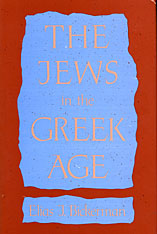 The Jews in the Greek Age
Elias Bickerman
Harvard University Press, 1988 One of our century’s greatest authorities on the ancient world gives us here a vivid account of the Jewish people from the conquest of Palestine by Alexander the Great in 332 BCE to the revolt of the Maccabees. It is a rich story of Jewish social, economic, and intellectual life and of the relations between the Jewish community and the Hellenistic rulers and colonizers of Palestine—a historical narrative told with consummate skill.
Elias Bickerman portrays Jewish life in the context of a broader picture of the Near East and traces the interaction between the Jewish and Greek worlds throughout this period. He reconstructs the evidence concerning social and political structures; the economy of Hellenistic Jerusalem and Judea; Greek officials, merchants, and entrepreneurs as well as full-scale Greek colonies in Palestine; the impact of Greek language and culture among Jews and the translation of Jewish Scriptures into Greek; Jewish literature, learning, and law; and the diaspora in the Hellenistic period. He deploys his profound knowledge gracefully, weaving archaeological finds, literary traditions, the political and economic record, and fertile insights into an abundant and lively history.
This first full study of the pre-Maccabean interaction between the Greek and Jewish cultures will be welcomed by historians and specialists in Judaic studies. But any reader interested in the ancient Mediterranean world will find it to be filled with pleasures and discoveries.
Jews in the Netherlands: A Short History
Tirtsah Levie Bernfeld
Amsterdam University Press, 2023 Most people know little more than fragments of Dutch Jewish history: the Portuguese Jews of Amsterdam; Jewish socialism; the devastating years of the Second World War. So where is the storyline? What happened to the Jews in the Netherlands from the moment they first settled there permanently? This book answers that question. It presents the central points of 700 years of Jewish history in the Netherlands briefly and succinctly. One hundred elements of the story have been chosen that taken as a whole create a balanced and representative picture. Each relates to a central event, place, person or object that helps to illuminate one important aspect of the history of the Jews in the Netherlands, and each is linked to a striking, iconic image. They are grouped by century around unifying themes that make them part of an ongoing story.
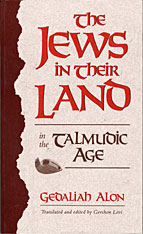 The Jews in Their Land in the Talmudic Age: 70–640 CE
Gedaliah Alon
Harvard University Press, 1989 This is a masterly narrative of the land of Israel from 70 to 640 CE by an eminent Israeli historian. It is a comprehensive record of Jewish life under Roman rule: economic conditions and social welfare; Jewish law and courts; political repression and resistance; religious controversies; the Diaspora and relations between the national center in Palestine and the communities abroad. Gedaliah Alon describes the rebuilding of national life after the defeat in 70; the emergence of the Sages as community leaders; the extent of autonomy under the Roman Empire; the towns and cities of Jewish Palestine; armed uprisings and the Bar Kokhba Revolt; the decades of decline and large-scale emigration; the traditions of learning that produced the Mishnah and Talmud. It is a rich, vividly told story.
This paperback reproduces in one volume the two-volume translation of Alon’s classic work published in Jerusalem in 1980 and 1984.
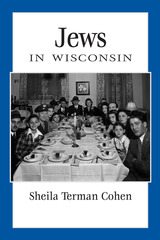 Jews in Wisconsin
Sheila Terman Cohen
Wisconsin Historical Society Press, 2016 Unlike the other cultural groups covered in the People of Wisconsin series, the Jews who have made their home in Wisconsin are united not by a single country of origin, but by a shared history and set of religious beliefs. This diverse group found their way to America’s heartland over several centuries from Germany, Russia, and beyond, some fleeing violence and persecution, others searching for new opportunities, but all making important contributions to the fabric of this state’s history. Through detailed historical information and personal accounts, Sheila Terman Cohen brings to life the stories of their various trials and triumphs. Jews in Wisconsin details their battles against anti-Semitism, their efforts to participate in the communities they joined, and their successes at holding onto their own cultural identities. In addition to excerpts of Cohen’s many interviews with Wisconsin Jews, Jews in Wisconsin also features the compelling journals of German immigrant Louis Heller, a tradesman who established himself in Milwaukee, and Russian immigrant Azriel Kanter, who details the perilous journey his family embarked on to escape anti-Semitism in his home country and make a new life in Wisconsin.
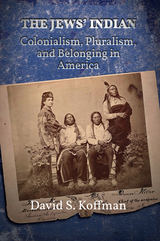 The Jews’ Indian: Colonialism, Pluralism, and Belonging in America
Koffman, David S
Rutgers University Press, 2019 Winner of the 2020 Jordan Schnitzer Book Award in Social Science, Anthropology, and Folklore
Honorable Mention, 2021 Saul Viener Book Prize
The Jews’ Indian investigates the history of American Jewish relationships with Native Americans, both in the realm of cultural imagination and in face-to-face encounters. These two groups’ exchanges were numerous and diverse, proving at times harmonious when Jews’ and Natives people’s economic and social interests aligned, but discordant and fraught at other times. American Jews could be as exploitative of Native cultural, social, and political issues as other American settlers, and historian David Koffman argues that these interactions both unsettle and historicize the often triumphant consensus history of American Jewish life. Focusing on the ways Jewish class mobility and civic belonging were wrapped up in the dynamics of power and myth making that so severely impacted Native Americans, this books is provocative and timely, the first history to critically analyze Jewish participation in, and Jews’ grappling with the legacies of Native American history and the colonial project upon which America rests.
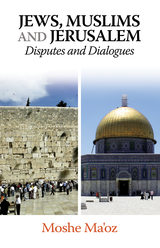 Jews, Muslims and Jerusalem: Disputes and Dialogues
Moshe Ma'Oz
Sussex Academic Press, 2022 Jews, Muslims and Jerusalem: Disputes and Dialogues ;examines MuslimJewish relations during significant periods of history in the Middle East, Asia and Africa. A deep concern in the Muslim Arab world concerns the status of the Al-Aqsa Mosque and Dome of the Rock. Israel's continued occupation of the West Bank since 1967, and its control of East Jerusalem, has reinforced anti-Jewish (Judeophobia) and anti-Israel movements. The most prominent are the Hamas, the "Liberation" Party (tahrir), the Islamic Jihad, Hizbullah, the Islamic rulers in Iran, and recently Turkey. Conversely, amongst Jews in Israel and the Diaspora (and amongst many Christians) the last decades have witnessed a rise in extreme Islamophobia in reaction to Arab terrorist attacks, and out of a religious-cultural prejudice against Muslims. Spearheading these trends are members of the Jewish underground, Gush Emunim, Loyalists of the Temple Mount, Holy Temple organizations, and members of the religious Zionist and political movements, the Bayit Yehudi Party and Likud Party. It is noteworthy that there are numerous proactive movements for coexistence and peace amongst Jews and Muslims in Israel and throughout the world, and in that prevailing spirit dozens of ongoing religious and cultural dialogues are maintained. These interactions, and the political and economic engagement at state level, are distinguished by ambivalence given not only the historical record but through contemporary zealotary by hardliners. The US, the UN and the EU have tried to mediate, but to no avail. President Trump's "Deal of the Century" has abandoned Washington's neutrality. PM Netanyahu promotes Israeli sovereignty over Jerusalem. This book is the most comprehensive, integrated and updated study on these formidable issues. Given the increasingly volatile language by hardline players the Middle East is at a point of critical historical change: Is it to be a political settlement via dialogue or a downward spiral to a dispute that in an age of offensive weaponry available to all parties can only have dire consequences.
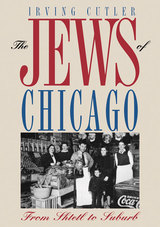 The Jews of Chicago: From Shtetl to Suburb
Irving Cutler
University of Illinois Press, 1994 Vividly told and richly illustrated with more than 160 photographs, The Jews of Chicago is the fascinating story of the cultural, religious, fraternal, economic, and everyday life of Chicago's Jews. This edition of Irving Cutler's definitive historical volume also includes a new foreword written by the author. The first comprehensive history of Chicago's Jewish population in eighty years, The Jews of Chicago brings to life the people, events, neighborhoods, and institutions that helped shape today's Jewish community. Cutler intertwines neighborhood histories with representative biographical vignettes of some of Chicago's best known figures, such as Edna Ferber, Saul Bellow, Benny Goodman, Mel Tormé, Studs Terkel, Paul Muni, Mandy Patinkin, Emil G. Hirsch, Julius Rosenwald, Dankmar Adler, Arthur Goldberg, Philip Klutznick, and many others. From their roots in the Old Country to their present-day communities, Cutler captures in extraordinary detail the remarkable saga of the Jews of Chicago.
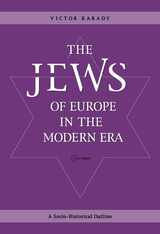 The Jews of Europe in the Modern Era: A Socio-Historical Outline
Victor Karady
Central European University Press, 2003 Discusses the socio-historical problem areas related to the presence of Jews in major European societies from the 18th century to our days; differently from most other studies, covers the post-Shoah situation also. The approach is multi-disciplinary, mobilizing resources gained from sociology, demography and political science, based on substantial statistical information. Presents and compares the different patterns of Jewish policies of the emerging nation states and established empires. Discusses education and socio-professional stratification of Jews. Deals with the challenges of emancipation and assimilation, the emergence of Jewish nationalism in various forms, Zionism above all, as well as antisemitic ideologies. The book ends with a scrutiny of post-Shoah situation opposing in this regard Western Europe to the Sovietised East, discussing finally strategies of dissimulation or reconstruction of Jewish identity.
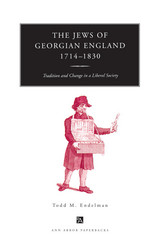 The Jews of Georgian England, 1714-1830: Tradition and Change in a Liberal Society
Todd M. Endelman
University of Michigan Press, 1999 The movement from tradition to modernity engulfed all of the Jewish communities in the West, but hitherto historians have concentrated on the intellectual revolution in Germany by Moses Mendelssohn in the second half of the eighteenth century as the decisive event in the origins of Jewish modernity. In The Jews of Georgian England, Todd M. Endelman challenges the Germanocentric orientation of the bulk of modern Jewish historiography and argues that the modernization of European Jewry encompassed far more than an intellectual revolution.
His study recounts the rise of the Anglo-Jewish elite--great commercial and financial magnates such as the Goldsmids, the Franks, Samson Gideon, and Joseph Salvador--who rapidly adopted the gentlemanly style of life of the landed class and adjusted their religious practices to harmonize with the standards of upper-class Englishmen. Similarly, the Jewish poor--peddlers, hawkers, and old-clothes men--took easily to many patterns of lower-class life, including crime, street violence, sexual promiscuity, and coarse entertainment.
An impressive marshaling of fact and analysis, The Jews of Georgian England serves to illuminate a significant aspect of the Jewish passage to modernity.
"Contributes to English as well as Jewish history. . . . Every reader will learn something new about the statistics, setting or mores of Jewish life in the eighteenth century. . . ." --American Historical Review
Todd M. Endelman is William Haber Professor of Modern Jewish History, University of Michigan. He is also the author of Comparing Jewish Societies, Jewish Apostasy in the Modern World, and Radical Assimilation in English Jewish History, 1656-1945.
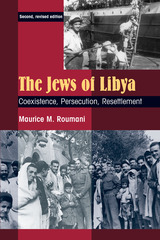 The Jews of Libya: Coexistence, Persecution, Resettlement, Second Revised Edition
Maurice Roumani
Sussex Academic Press, 2022 In this revised edition Prof. Roumani presents new and original material on the deportation of Libyan Jews to French North Africa, offering new insights and aspects of the consequences of the Racial Laws and of anti-Semitism as rooted in Fascist ideology. He reveals one the unknown incidents (accidents) of the war, the bombing of La Marsa, and the resulting massacre of many Libyan Jews. The end of the war witnessed the complicated negotiations among the Allied forces in the repatriation of the deportees and the mediation of the AJDC in aiding the resettlement of the deportees in their native countries. Reviews and endorsements of the original publication are available on the Press website. They include: "He uses a wide range of archival and oral sources, many of which have never been used before. Throughout the book, he reveals a mastery of the social and political history, and a fine understanding of the lives, hopes, fears and aspirations of Libyan Jews," From the Foreword by Sir Martin Gilbert.
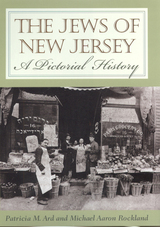 The Jews of New Jersey: A Pictorial History
Patricia M. Ard and Michael Aaron Rockland
Rutgers University Press, 2001 Jews have called New Jersey home since the late seventeenth century, and they currently make up almost 6 percent of the states residents. Yet, until now, no book has paid tribute to the richness of Jewish heritage in the Garden State. The Jews of New Jersey: A Pictorial History redresses this lack with a lively narrative and hundreds of archival and family photographsmany rarethat bring this history to life. Patricia Ard and Michael Rockland focus on representative Jewish communities throughout the state, paying particular attention to the extraordinary stories of ordinary people. Through the joys and struggles of homemakers, storekeepers, factory workers, athletes, children, farmers, activists, religious leaders, and Holocaust survivors, the authors tell the stories of how these communities have evolved, thrived, and changed. They note the difficulties posed by intermarriage and assimilation and, at the same time, depict a burgeoning revival of Jewish orthodoxy and traditions. The Jews of New Jersey will please both the historian and general reader. Its heartwarming stories and pictures truly make the point that it is through the joys, triumphs, and defeats of everyday people that history is made.
The Jews of Poland Between Two World Wars
Edited by Yisrael Gutman
Brandeis University Press, 1991 Jews have long seen the interwar years as a “golden age” for Polish Jewry and hold it in special reverence because of the community’s heroic struggle against the encroaching darkness of antisemitism. During the years 1918 to 1939, Polish Jews constituted the largest Jewish community in noncommunist Europe and were the leading cultural and political force in the Jewish Diaspora. In this volume distinguished American, West European, Israeli, and Polish scholars combine forces to explore the politics, antisemitism, economic and social life, religious patterns, and cultural creativity of a period whose relevance is heightened because of current changes under way in Eastern Europe.
Jews, Sports, and the Rites of Citizenship
Edited by Jack Kugelmass
University of Illinois Press, 2006 To many, an association between Jews and sports seems almost oxymoronic--yet Jews have been prominent in boxing, basketball, and fencing, and some would argue that hurler Sandy Koufax is America's greatest athlete ever. In Jews, Sports, and the Rites of Citizenship, Jack Kugelmass shows that sports--significant in constructing nations and in determining their degree of exclusivity--also figures prominently in the Jewish imaginary. This interdisciplinary collection brings together the perspectives of anthropologists and historians to provide both methodological and regional comparative frameworks for exploring the meaning of sports for a minority population.
Jews, Turks, and Other Strangers: Roots of Prejudice in Modern Germany
Jerome S. Legge, Jr.
University of Wisconsin Press, 2003 Scholarly, objective, insightful, and analytical, Jews, Turks, and Other Strangers studies the causes of prejudice against Jews, foreign workers, refugees, and emigrant Germans in contemporary Germany. Using survey material and quantitative analyses, Legge convincingly challenges the notion that German xenophobia is rooted in economic causes. Instead, he sees a more complex foundation for German prejudice, particularly in a reunified Germany where perceptions of the "other" sometimes vary widely between east and west, a product of a traditional racism rooted in the German past. By clarifying the foundations of xenophobia in a new German state, Legge offers a clear and disturbing picture of a conflicted country and a prejudice that not only affects Jews but also fuels a larger, anti-foreign sentiment.
Jews Welcome Coffee: Tradition and Innovation in Early Modern Germany
Robert Liberles
Brandeis University Press, 2012 Tracing the introduction of coffee into Europe, Robert Liberles challenges long-held assumptions about early modern Jewish history and shows how the Jews harnessed an innovation that enriched their personal, religious, social, and economic lives. Focusing on Jewish society in Germany in the seventeenth and eighteenth centuries, and using coffee as a key to understanding social change, Liberles analyzes German rabbinic rulings on coffee, Jewish consumption patterns, the commercial importance of coffee for various social strata, differences based on gender, and the efforts of German authorities to restrict Jewish trade in coffee, as well as the integration of Jews into society.
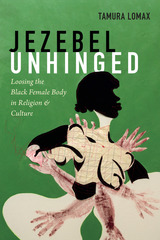 Jezebel Unhinged: Loosing the Black Female Body in Religion and Culture
Tamura Lomax
Duke University Press, 2018 In Jezebel Unhinged Tamura Lomax traces the use of the jezebel trope in the black church and in black popular culture, showing how it is pivotal to reinforcing men's cultural and institutional power to discipline and define black girlhood and womanhood. Drawing on writing by medieval thinkers and travelers, Enlightenment theories of race, the commodification of women's bodies under slavery, and the work of Tyler Perry and Bishop T. D. Jakes, Lomax shows how black women are written into religious and cultural history as sites of sexual deviation. She identifies a contemporary black church culture where figures such as Jakes use the jezebel stereotype to suggest a divine approval of the “lady” while condemning girls and women seen as "hos." The stereotype preserves gender hierarchy, black patriarchy, and heteronormativity in black communities, cultures, and institutions. In response, black women and girls resist, appropriate, and play with the stereotype's meanings. Healing the black church, Lomax contends, will require ceaseless refusal of the idea that sin resides in black women's bodies, thus disentangling black women and girls from the jezebel narrative's oppressive yoke.
JG vol 121 num 1
The University of Chicago Press
University of Chicago Press Journals, 2013
JG vol 121 num 2
The University of Chicago Press
University of Chicago Press Journals, 2013
JG vol 121 num 3
The University of Chicago Press
University of Chicago Press Journals, 2013
JG vol 121 num 4
The University of Chicago Press
University of Chicago Press Journals, 2013
JG vol 121 num 5
The University of Chicago Press
University of Chicago Press Journals, 2013
JG vol 121 num 6
The University of Chicago Press
University of Chicago Press Journals, 2013
JG vol 122 num 1
The University of Chicago Press
University of Chicago Press Journals, 2014
JG vol 122 num 2
The University of Chicago Press
University of Chicago Press Journals, 2014
JG vol 122 num 3
The University of Chicago Press
University of Chicago Press Journals, 2014
JG vol 122 num 4
The University of Chicago Press
University of Chicago Press Journals, 2014
JG vol 122 num 5
The University of Chicago Press
University of Chicago Press Journals, 2014
JG vol 122 num 6
The University of Chicago Press
University of Chicago Press Journals, 2014
JG vol 123 num 1
The University of Chicago Press
University of Chicago Press Journals, 2015
JG vol 123 num 2
The University of Chicago Press
University of Chicago Press Journals, 2015
JG vol 123 num 3
The University of Chicago Press
University of Chicago Press Journals, 2015
JG vol 123 num 4
The University of Chicago Press
University of Chicago Press Journals, 2015
JG vol 123 num 5
The University of Chicago Press
University of Chicago Press Journals, 2015
JG vol 123 num 6
The University of Chicago Press
University of Chicago Press Journals, 2015
JG vol 124 num 1
The University of Chicago Press
University of Chicago Press Journals, 2016
JG vol 124 num 2
The University of Chicago Press
University of Chicago Press Journals, 2016
JG vol 124 num 3
The University of Chicago Press
University of Chicago Press Journals, 2016
JG vol 124 num 4
The University of Chicago Press
University of Chicago Press Journals, 2016
JG vol 124 num 5
The University of Chicago Press
University of Chicago Press Journals, 2016
JG vol 124 num 6
The University of Chicago Press
University of Chicago Press Journals, 2016
JG vol 125 num 1
The University of Chicago Press
University of Chicago Press Journals, 2017
JG vol 125 num 2
The University of Chicago Press
University of Chicago Press Journals, 2017
JG vol 125 num 3
The University of Chicago Press
University of Chicago Press Journals, 2017
JG vol 125 num 4
The University of Chicago Press
University of Chicago Press Journals, 2017
JG vol 125 num 5
The University of Chicago Press
University of Chicago Press Journals, 2017
JG vol 125 num 6
The University of Chicago Press
University of Chicago Press Journals, 2017
JG vol 126 num 1
The University of Chicago Press
University of Chicago Press Journals, 2018
JG vol 126 num 2
The University of Chicago Press
University of Chicago Press Journals, 2018
JG vol 126 num 3
The University of Chicago Press
University of Chicago Press Journals, 2018
JG vol 126 num 4
The University of Chicago Press
University of Chicago Press Journals, 2018
JG vol 126 num 5
The University of Chicago Press
University of Chicago Press Journals, 2018
JG vol 126 num 6
The University of Chicago Press
University of Chicago Press Journals, 2018
JG vol 127 num 1
The University of Chicago Press
University of Chicago Press Journals, 2019
JG vol 127 num 2
The University of Chicago Press
University of Chicago Press Journals, 2019
JG vol 127 num 3
The University of Chicago Press
University of Chicago Press Journals, 2019
JG vol 127 num 4
The University of Chicago Press
University of Chicago Press Journals, 2019
JG vol 127 num 5
The University of Chicago Press
University of Chicago Press Journals, 2019
JG vol 127 num 6
The University of Chicago Press
University of Chicago Press Journals, 2019
JG vol 128 num 1
The University of Chicago Press
University of Chicago Press Journals, 2020
JG vol 128 num 2
The University of Chicago Press
University of Chicago Press Journals, 2020
JG vol 128 num 3
The University of Chicago Press
University of Chicago Press Journals, 2020
JG vol 128 num 4
The University of Chicago Press
University of Chicago Press Journals, 2020
JG vol 128 num 5
The University of Chicago Press
University of Chicago Press Journals, 2020
JG vol 128 num 6
The University of Chicago Press
University of Chicago Press Journals, 2020
JHC vol 10 num 1
The University of Chicago Press
University of Chicago Press Journals, 2016
JHC vol 10 num 2
The University of Chicago Press
University of Chicago Press Journals, 2016
JHC vol 10 num 3
The University of Chicago Press
University of Chicago Press Journals, 2016
JHC vol 10 num 4
The University of Chicago Press
University of Chicago Press Journals, 2016
JHC vol 11 num 1
The University of Chicago Press
University of Chicago Press Journals, 2017
JHC vol 11 num 2
The University of Chicago Press
University of Chicago Press Journals, 2017
JHC vol 11 num 3
The University of Chicago Press
University of Chicago Press Journals, 2017
JHC vol 11 num 4
The University of Chicago Press
University of Chicago Press Journals, 2017
JHC vol 12 num 1
The University of Chicago Press
University of Chicago Press Journals, 2018
JHC vol 12 num 2
The University of Chicago Press
University of Chicago Press Journals, 2018
JHC vol 12 num 3
The University of Chicago Press
University of Chicago Press Journals, 2018
JHC vol 12 num 4
The University of Chicago Press
University of Chicago Press Journals, 2018
JHC vol 13 num 1
The University of Chicago Press
University of Chicago Press Journals, 2019
JHC vol 13 num 2
The University of Chicago Press
University of Chicago Press Journals, 2019
JHC vol 13 num 3
The University of Chicago Press
University of Chicago Press Journals, 2019
JHC vol 13 num 4
The University of Chicago Press
University of Chicago Press Journals, 2019
JHC vol 14 num 1
The University of Chicago Press
University of Chicago Press Journals, 2020
JHC vol 14 num 2
The University of Chicago Press
University of Chicago Press Journals, 2020
JHC vol 14 num 3
The University of Chicago Press
University of Chicago Press Journals, 2020
JHC vol 14 num 4
The University of Chicago Press
University of Chicago Press Journals, 2020
JHC vol 7 num 1
The University of Chicago Press
University of Chicago Press Journals, 2013
JHC vol 7 num 2
The University of Chicago Press
University of Chicago Press Journals, 2013
JHC vol 7 num 3
The University of Chicago Press
University of Chicago Press Journals, 2013
JHC vol 7 num 4
The University of Chicago Press
University of Chicago Press Journals, 2013
JHC vol 8 num 1
The University of Chicago Press
University of Chicago Press Journals, 2014
JHC vol 8 num 2
The University of Chicago Press
University of Chicago Press Journals, 2014
JHC vol 8 num 3
The University of Chicago Press
University of Chicago Press Journals, 2014
JHC vol 8 num 4
The University of Chicago Press
University of Chicago Press Journals, 2014
JHC vol 9 num 1
The University of Chicago Press
University of Chicago Press Journals, 2015
JHC vol 9 num 2
The University of Chicago Press
University of Chicago Press Journals, 2015
JHC vol 9 num 3
The University of Chicago Press
University of Chicago Press Journals, 2015
JHC vol 9 num 4
The University of Chicago Press
University of Chicago Press Journals, 2015
Jia Zhangke on Jia Zhangke
Michael Berry
Duke University Press, 2022 Jia Zhangke on Jia Zhangke is an extended dialogue between film scholar Michael Berry and the internationally acclaimed Chinese filmmaker. Drawing from extensive interviews and public talks, this volume offers a portrait of Jia’s life, art, and approach to filmmaking. Jia and Berry’s conversations range from Jia’s childhood and formative years to extensive discussions of his major narrative films, including the classics Xiao Wu, Platform, The World, Still Life, and A Touch of Sin. Jia gives a firsthand account of his influences, analyzes the Chinese film industry, and offers his thoughts on subjects such as film music, working with actors, cinematography, and screenwriting. From industry and economics to art and politics, Jia Zhangke on Jia Zhangke represents the single most comprehensive document of the director’s candid thoughts on the art and challenges of filmmaking.
Jihad and Islam in World War I: Studies on the Ottoman Jihad on the Centenary of Snouck Hurgronje's "Holy War Made in Germany"
Edited by Erik-Jan Zürcher
Leiden University Press, 2015 Today’s headlines are full of references to jihad and jihadists, but they’re nothing new: a century ago, the entry of the Ottoman Empire into World War I was accompanied by a loud proclamation of jihad as well. This book resurrects that largely forgotten aspect of the war, investigating the background and nature of the proclamation, as well as its effects in the wider Middle East, the fears it stoked among German and British military leaders, and the accompanying academic debates about holy war and Islam.
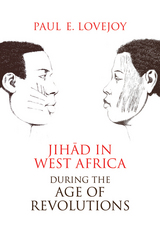 Jihad in West Africa during the Age of Revolutions
Paul E. Lovejoy
Ohio University Press, 2016 In Jihād in West Africa during the Age of Revolutions, a preeminent historian of Africa argues that scholars of the Americas and the Atlantic world have not given Africa its due consideration as part of either the Atlantic world or the age of revolutions. The book examines the jihād movement in the context of the age of revolutions—commonly associated with the American and French revolutions and the erosion of European imperialist powers—and shows how West Africa, too, experienced a period of profound political change in the late eighteenth through the mid-nineteenth centuries. Paul E. Lovejoy argues that West Africa was a vital actor in the Atlantic world and has wrongly been excluded from analyses of the period. Among its chief contributions, the book reconceptualizes slavery. Lovejoy shows that during the decades in question, slavery expanded extensively not only in the southern United States, Cuba, and Brazil but also in the jihād states of West Africa. In particular, this expansion occurred in the Muslim states of the Sokoto Caliphate, Fuuta Jalon, and Fuuta Toro. At the same time, he offers new information on the role antislavery activity in West Africa played in the Atlantic slave trade and the African diaspora. Finally, Jihād in West Africa during the Age of Revolutions provides unprecedented context for the political and cultural role of Islam in Africa—and of the concept of jihād in particular—from the eighteenth century into the present. Understanding that there is a long tradition of jihād in West Africa, Lovejoy argues, helps correct the current distortion in understanding the contemporary jihād movement in the Middle East, Afghanistan, Pakistan, and Africa.
 Jihad: The Trail of Political Islam
Gilles Kepel
Harvard University Press, 2002 The late twentieth century has witnessed the emergence of an unexpected and extraordinary phenomenon: Islamist political movements. Beginning in the early 1970s, militants revolted against the regimes in power throughout the Muslim world and exacerbated political conflicts everywhere. Their jihad, or “Holy Struggle,” aimed to establish a global Islamic state based solely on a strict interpretation of the Koran. Religious ideology proved a cohesive force, gathering followers ranging from students and the young urban poor to middle-class professionals.
After an initial triumph with the Islamic revolution in Iran, the movement waged jihad against the USSR in Afghanistan, proclaiming for the first time a doctrine of extreme violence. By the end of the 1990s, the failure to seize political power elsewhere led to a split: movement moderates developed new concepts of “Muslim democracy” while extremists resorted to large-scale terrorist attacks around the world.
Jihad is the first extensive, in-depth attempt to follow the history and geography of this disturbing political-religious phenomenon. Fluent in Arabic, Gilles Kepel has traveled throughout the Muslim world gathering documents, interviews, and archival materials inaccessible to most scholars, in order to give us a comprehensive understanding of the scope of Islamist movements, their past, and their present. As we confront the threat of terrorism to our lives and liberties, Kepel helps us make sense of the ominous reality of jihad today.
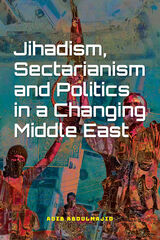 Jihadism, Sectarianism and Politics in a Changing Middle East
Adib Abdulmajid
Eburon Academic Publishers, 2021 An exploration of sectarianism, Islamism, and jihadism in the contemporary Middle East.
The emergence and growth of sectarian Islamist militant organizations, whether Sunni or Shia, is deemed to be the fruit of the emerging radical interpretations of the concept of jihad, and the evolution of Islamism in general. The main objective of this book is to help the reader understand the complex religio-political scene in today’s Middle East and the ideological principles and agendas of influential movements, whose beliefs and actions constitute a serious threat to cultural diversity in the region. It addresses the doctrinal tenets associated with the emergence of influential Islamist organizations and the challenges encountered by the culturally diverse populations that surround them. This book also delves into the historical events that have shaped the Middle East as we know it today. It further examines the key factors behind the rise of the most influential sectarian-guided, jihadi-based extremist groups in the recent years
 Jill Johnston in Motion: Dance, Writing, and Lesbian Life
Clare Croft
Duke University Press, 2024 Performer, activist, and writer Jill Johnston was a major queer presence in the history of dance and 1970s feminism. She was the first critic to identify postmodernism’s arrival in American dance and was a fierce advocate for the importance of lesbians within feminism. In Jill Johnston in Motion, Clare Croft tracks Johnston’s entwined innovations and contributions to dance and art criticism and activism. She examines Johnston’s journalism and criticism—in particular her Village Voice columns published between 1960 and 1980—and her books of memoir and biography. At the same time, Croft attends to Johnston’s appearances as both dancer and audience member and her physical and often spectacular participation at feminist protests. By bringing together Johnston’s criticism and activism, her writing and her physicality, Croft emphasizes the effect that the arts, particularly dance, had on Johnston’s feminist thinking in the 1970s and traces lesbian feminism’s roots in avant-garde art practice.
 Jim Bunning
Frank Dolson
Temple University Press, 1998 Jim Bunning began as a $150-a-month rookie in Richmond, Indiana, spent seven years in the minor leagues, and still made it to the Hall of Fame. He pitched a no-hitter against the Boston Red Sox in Fenway Park, even though the first-base coach was relaying his catcher's signs to the batters, retiring Ted Williams for the final out. Bunning also pitched an historic perfect game against the New York Mets and performed spectacularly in a succession of All-Star Game appearances.
He was the second pitcher in major league history to win 100 games in each league. The first was CY Young. He was the second pitcher to strike out 1000 in each league; again, only Cy Young beat hims to it. When Bunning retired at the end of the 1971 season, only one man -- Walter Johnson -- had more career strikeouts.
A proud, intensely competitive man, Bunning relished his duels with Ted Williams, Micky Mantle, and other slugging superstars of the day. What he didn't relish was dealing with sportswriter who didn't do their homework and with baseball leaders whose mismanagement, Bunning felt, jeopardized the game's place in the nation's heart. He waged battles with the likes of former commissioner Peter Ueberroth and club-owner-turned-interim-commissioner Bud Selig.
But Bunning did more than play baseball. He was a driving force in the early years of the Players Association, one of the men responsible for choosing Marvin Miller as head of the union. Bunning also was a manager in the minor leagues and in Puerto Rico and the Dominican Republic and was even a player's agent for a time. His baseball career behind him, he began a second career in politics. With a huge assist from his wife, Mary, the mother of their nine children, he waged an unsuccessful gubernational campaign in Kentucky and then became a six-term congressman. Bunning is currently running for the U.S. Senate seat in Kentucky.
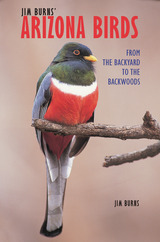 Jim Burns' Arizona Birds: From the Backyard to the Backwoods
Jim Burns
University of Arizona Press, 2008 Arizona is renowned as a premier birding state, a place where many species rarely seen anywhere else in the country reach the northern end of their migratory range. Jim Burns’ Arizona Birds is a lively portrayal of the habits and habitats of seventy-five of these unique southwestern species. Burns has written much more than a field guide, site guide, or scientific survey. He has compiled and expanded upon his feature column Arizona Special Species to create an original kind of birding book that is more at home on your bedside table than in your backpack. Bird-watchers new to the game will find a wealth of knowledge on and insight into some familiar favorites, as well as an idea of what it takes to accomplish more uncommon sightings.
Veteran birders will appreciate Burns’ unique incorporation of natural history and other details beyond the usual taxonomic data, and will enjoy reminders of their own triumphs and heartbreaks in his colorful personal accounts of vehicular breakdowns, photographic faux pas, and egregious identification errors in the field. Illustrated in full color by seventy-five of the author’s own outstanding photographs, this book also features a five-level rating system, beginning with birds you can see in your own backyard and ending with those requiring either pure dumb luck or years of study and perseverance to spot. But whether you have spent years in search of the Flammulated Owl or are just curious about the wildlife in your desert backyard, this book will have you laughing, learning, and reaching for the binoculars in hopes of creating your own encounters with Arizona’s incredible bird species.
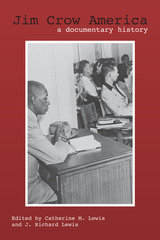 Jim Crow America: A Documentary History
Catherine M. Lewis
University of Arkansas Press, 2009 The term “Jim Crow” has had multiple meanings and a dark and complex past. It was first used in the early nineteenth century. After the Civil War it referred to the legal, customary, and often extralegal system that segregated and isolated African Americans from mainstream American life. In response to the increasing loss of their rights of citizenship and the rising tide of violence, the National Association for the Advancement of Colored People was founded in 1909. The federal government eventually took an active role in dismantling Jim Crow toward the end of the Depression. But it wasn’t until the Lyndon Johnson years and all the work that led up to them that the end of Jim Crow finally came to pass. This unique book provides readers with a wealth of primary source materials from 1828 to 1980 that reveal how the Jim Crow era affects how historians practice their craft. The book is chronologically organized into five sections, each of which focuses on a different historical period in the story of Jim Crow: inventing, building, living, resisting, and dismantling. Many of the fifty-six documents and eighteen images and cartoons, many of which have not been published before, reveal something significant about this subject or offer an unconventional or unexpected perspective on this era. Some of the historical figures whose words are included are Abraham Lincoln, Marcus Garvey, Booker T. Washington, Richard Wright, Paul Robeson, Langston Hughes, Adam Clayton Powell, and Marian Anderson. The book also has an annotated bibliography, a list of key players, a timeline, and key topics for consideration.
 Jim Crow, American: Selected Songs and Plays
T. D. Rice
Harvard University Press, 2009 Jim Crow is the figure that has long represented America’s imperfect union. When the white actor Thomas D. Rice took to the stage in blackface as Jim Crow, during the 1830s, a ragged and charismatic trickster began channeling black folklore through American popular culture. This compact edition of the earliest Jim Crow plays and songs presents essential performances that assembled backtalk, banter, masquerade, and dance into the diagnostic American style. Quite contrary to Jim Crow’s reputation—which is to say, the term’s later meaning—these early acts undermine both racism and slavery. They celebrate an irresistibly attractive blackness in a young Republic that had failed to come together until Americans agreed to disagree over Jim Crow’s meaning.
As they permeated American popular culture, these distinctive themes formed a template which anticipated minstrel shows, vaudeville, ragtime, jazz, early talking film, and rock ‘n’ roll. They all show whites using rogue blackness to rehearse their mutual disaffection and uneven exclusion.
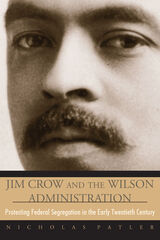 Jim Crow and the Wilson Administration: Protesting Federal Segregation in the Early Twentieth Century
Nicholas Patler
University Press of Colorado, 2007 In Jim Crow and the Wilson Administration, Nicholas Patler presents the first in-depth study of the historic protest movement that challenged federal racial segregation and discrimination during the first two years of Woodrow Wilson's presidency. Before the Wilson years, as southern states and localities enshrined Jim Crow--in law and custom--and systematic racial discrimination infiltrated the North, the executive branch of the federal government moved in the opposite direction by opening federal employment to thousands of African Americans, appointing blacks to federal and diplomatic offices throughout the country and the world. Finding support from the federal government, many African Americans, supported Wilson's democratic campaign, dubbed the "New Freedom," with hopes of continuing advancement. But as president, the southern-born Wilson openly supported and directly implemented a Jim Crow policy in the federal departments unleashing a firestorm of protest. This protest campaign, carried out on a level not seen since the abolitionist movement, galvanized a vast community of men and women. Blacks and whites, professionals and laymen, signed petitions, wrote protest letters, participated in organized mass meetings, lobbied public officials, directly confronted Wilson, made known their plight through publicity campaigns, and, in at least one case, marched to express their opposition. Patler provides a thorough examination of the two national organizations that led these protests efforts - the National Association for the Advancement of Colored People and William Monroe Trotter's National Equal Rights League - and deftly contextualizes the movement, while emphasizing the tragic, enduring consequences of the Wilson administration's actions.
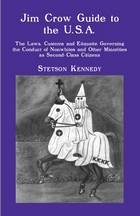 Jim Crow Guide to the U.S.A.: The Laws, Customs and Etiquette Governing the Conduct of Nonwhites and Other Minorities as Second-Class Citizens
Stetson Kennedy
University of Alabama Press, 2011 “A history of the United States that is almost incredible.” —Jean-Paul Sartre, Les Temps Modernes Jim Crow Guide to the U.S.A. by Stetson Kennedy is a bold exposé of America’s institutionalized racism, originally published in 1959 and hailed as a landmark in civil rights literature. With unflinching clarity, Kennedy documents the laws, customs, and social codes that relegated nonwhite citizens to second-class status under the Jim Crow system. From the mistreatment of Native Americans to the exclusionary immigration policies targeting Asians and Africans, the book maps the presence of race-based politics across every facet of American life—housing, education, employment, and even burial. What makes this work especially influential is its international resonance. The famed French existentialist Jean-Paul Sartre championed the book’s publication in Europe, recognizing its power to illuminate the contradictions between American democratic ideals and racial realities. Sartre’s endorsement helped position the book as a global indictment of racial injustice, aligning it with anti-colonial and human rights movements worldwide. Provocative, meticulously researched, and deeply human, Jim Crow Guide to the U.S.A. remains a vital historical document and a call to conscience. It is not merely a guide—it is a mirror held up to a nation, reflecting truths that later generations were called on to address.
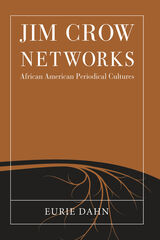 Jim Crow Networks: African American Periodical Cultures
Eurie Dahn
University of Massachusetts Press, 2021 Scholars have paid relatively little attention to the highbrow, middlebrow, and popular periodicals that African Americans read and discussed regularly during the Jim Crow era—publications such as the Chicago Defender, the Crisis, Ebony, and the Half-Century Magazine. Jim Crow Networks considers how these magazines and newspapers, and their authors, readers, advertisers, and editors worked as part of larger networks of activists and thinkers to advance racial uplift and resist racism during the first half of the twentieth century.
As Eurie Dahn demonstrates, authors like James Weldon Johnson, Nella Larsen, William Faulkner, and Jean Toomer wrote in the context of interracial and black periodical networks, which shaped the literature they produced and their concerns about racial violence. This original study also explores the overlooked intersections between the black press and modernist and Harlem Renaissance texts, and highlights key sites where readers and writers worked toward bottom-up sociopolitical changes during a period of legalized segregation.
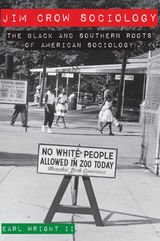 Jim Crow Sociology: The Black and Southern Roots of American Sociology
Earl Wright
University of Cincinnati Press, 2020 Jim Crow Sociology: The Black and Southern Roots of American Sociology is an extraordinary new volume that examines the origin, development, and significance of Black Sociology through the accomplishments of early African American sociologists at Historically Black Colleges and Universities (HBCUs) such as Atlanta University, Tuskegee Institute, Fisk University, and Howard University. Black Sociology is a concept that weaponizes the discipline for that which is “right and good” and prioritizes scholar-activist inspired research directed at impacting real world conditions of African Americans.
Guided by this approach, this book debunks the idea that the sociology practiced by early African Americans does not exemplify scholarly excellence. Instead, Earl Wright demonstrates that Tuskegee Institute, under the leadership of Booker T. Washington, established the first applied program of rural sociology. Fisk University, first under the guidance of George Edmund Haynes then Charles S. Johnson, developed one of the earliest and most impactful programs of applied urban sociology. Wright extends our understanding of W. E. B. Du Bois’s Atlanta Sociological Laboratory with an articulation of the contributions of women to the first American school of sociology. Jim Crow Sociology forces contemporary scholars to grapple with who are and who are not included in the disciplinary canon. Specifically, this book forces us to ask why early African American sociologists and HBCUs are not canonized. What makes this book most consequential is that it provides evidence supporting the proposition that sociology began in earnest in the United States as a Black and southern enterprise.
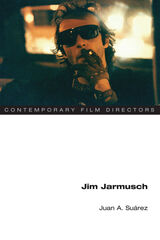 Jim Jarmusch
Juan A. Suarez
University of Illinois Press, 2006 The first major English-language study of Jarmusch At a time when gimmicky, action-driven blockbusters ruled Hollywood, Jim Jarmusch spearheaded a boom in independent cinema by making now-classic low-budget films like Stranger than Paradise, Down by Law, and Mystery Train. Jarmusch's films focused on intimacy, character, and new takes on classical narratives. His minimal form, peculiar pacing, wry humor, and blank affect have since been adopted by directors like Sofia Coppola, Hal Hartley, Richard Linklater, and Tsai Ming-liang. Juan A. Suárez identifies and describes an abundance of aesthetic influences on Jarmusch, delving into the director's links to punk, Structural film, classic street photography, hip-hop, beat literature and art, and the New York pop vanguard of the late 1970s. At the same time, he analyzes Jarmusch's work from three mutually implicated perspectives: in relation to independent filmmaking from the 1980s to the present; as a form of cultural production that appropriates existing icons, genres, and motifs; and as an instance of postmodern politics. A volume in the series Contemporary Film Directors, edited by James R. Naremore
 Jin Ping Mei – A Wild Horse in Chinese Literature: Essays on Texts, Illustrations and Translations of a Late Sixteenth-Century Masterpiece
Edited by Vibeke Børdahl and Lintao Qi
National University of Singapore Press, 2022 The late 16th-century novel Jin Ping Mei has been described as a landmark in the development of the narrative art form, there being no earlier work of prose fiction of equal sophistication in world literature. However, it is also seen as something of a wild horse, its graphically explicit depiction of sexuality earning it great notoriety. Although Jin Ping Mei was banned soon after its appearance, today the novel is considered one of the six classics of Chinese literature. It is thus no surprise that Jin Ping Mei has caught the attention of scholars working in many different fields, places and periods. Unfortunately, the interdisciplinary and transnational exchange has been limited here, in part because of distance and language barriers. The present volume aims to bridge this gap, bringing together the best quality research on Jin Ping Mei by both established and emerging scholars. Not only will it showcase research on Jin Ping Mei but also it will function as a reader, helping future generations to understand and appreciate this important work.
JLE vol 56 num 1
The University of Chicago Press
University of Chicago Press Journals, 2014
JLE vol 56 num 2
The University of Chicago Press
University of Chicago Press Journals, 2014
JLE vol 56 num 3
The University of Chicago Press
University of Chicago Press Journals, 2014
JLE vol 56 num 4
The University of Chicago Press
University of Chicago Press Journals, 2014
JLE vol 57 num 1
The University of Chicago Press
University of Chicago Press Journals, 2015
JLE vol 57 num 2
The University of Chicago Press
University of Chicago Press Journals, 2015
JLE vol 57 num 3
The University of Chicago Press
University of Chicago Press Journals, 2015
JLE vol 57 num 4
The University of Chicago Press
University of Chicago Press Journals, 2015
JLE vol 57 num S3
The University of Chicago Press
University of Chicago Press Journals, 2015
JLE vol 58 num 1
The University of Chicago Press
University of Chicago Press Journals, 2016
JLE vol 58 num 2
The University of Chicago Press
University of Chicago Press Journals, 2016
JLE vol 58 num 3
The University of Chicago Press
University of Chicago Press Journals, 2016
JLE vol 58 num 4
The University of Chicago Press
University of Chicago Press Journals, 2015
JLE vol 59 num 1
The University of Chicago Press
University of Chicago Press Journals, 2016
JLE vol 59 num 2
The University of Chicago Press
University of Chicago Press Journals, 2016
JLE vol 59 num 3
The University of Chicago Press
University of Chicago Press Journals, 2016
JLE vol 59 num 4
The University of Chicago Press
University of Chicago Press Journals, 2016
JLE vol 60 num 1
The University of Chicago Press
University of Chicago Press Journals, 2017
JLE vol 60 num 2
The University of Chicago Press
University of Chicago Press Journals, 2017
JLE vol 60 num 3
The University of Chicago Press
University of Chicago Press Journals, 2017
JLE vol 60 num 4
The University of Chicago Press
University of Chicago Press Journals, 2017
JLE vol 61 num 1
The University of Chicago Press
University of Chicago Press Journals, 2018
JLE vol 61 num 2
The University of Chicago Press
University of Chicago Press Journals, 2018
JLE vol 61 num 3
The University of Chicago Press
University of Chicago Press Journals, 2018
JLE vol 61 num 4
The University of Chicago Press
University of Chicago Press Journals, 2018 This is volume 61 issue 4 of The Journal of Law and Economics. Established in 1958, the Journal of Law and Economics publishes research on a broad range of topics, including the economic analysis of law, the economic analysis of regulation and the behavior of regulated firms, industrial organization and antitrust policy, the political economy of legislation and legislative processes, law and finance, and corporate finance and governance. The JLE has published some of the most influential and widely cited articles in these areas. It is an invaluable resource for academics and those interested in cutting-edge analysis of current public policy issues.
JLE vol 62 num 1
The University of Chicago Press
University of Chicago Press Journals, 2019
JLE vol 62 num 2
The University of Chicago Press
University of Chicago Press Journals, 2019
JLE vol 62 num 3
The University of Chicago Press
University of Chicago Press Journals, 2019
JLE vol 62 num 4
The University of Chicago Press
University of Chicago Press Journals, 2019
JLE vol 63 num 1
The University of Chicago Press
University of Chicago Press Journals, 2020
JLE vol 63 num 2
The University of Chicago Press
University of Chicago Press Journals, 2020
JLE vol 63 num 3
The University of Chicago Press
University of Chicago Press Journals, 2020
JLS vol 42 num 1
The University of Chicago Press
University of Chicago Press Journals, 2013
JLS vol 42 num 2
The University of Chicago Press
University of Chicago Press Journals, 2013
JLS vol 43 num 1
The University of Chicago Press
University of Chicago Press Journals, 2014
JLS vol 43 num 2
The University of Chicago Press
University of Chicago Press Journals, 2014
JLS vol 43 num S2
The University of Chicago Press
University of Chicago Press Journals, 2014
JLS vol 44 num 1
The University of Chicago Press
University of Chicago Press Journals, 2015
JLS vol 44 num 2
The University of Chicago Press
University of Chicago Press Journals, 2015
JLS vol 44 num S1
The University of Chicago Press
University of Chicago Press Journals, 2015
JLS vol 44 num S2
The University of Chicago Press
University of Chicago Press Journals, 2015
JLS vol 45 num 1
The University of Chicago Press
University of Chicago Press Journals, 2016
JLS vol 45 num 2
The University of Chicago Press
University of Chicago Press Journals, 2016
JLS vol 45 num S2
The University of Chicago Press
University of Chicago Press Journals, 2016
JLS vol 46 num 1
The University of Chicago Press
University of Chicago Press Journals, 2017
JLS vol 46 num 2
The University of Chicago Press
University of Chicago Press Journals, 2017
JLS vol 47 num 1
The University of Chicago Press
University of Chicago Press Journals, 2018
JLS vol 47 num 2
The University of Chicago Press
University of Chicago Press Journals, 2018
JLS vol 47 num S1
The University of Chicago Press
University of Chicago Press Journals, 2018
JLS vol 48 num 1
The University of Chicago Press
University of Chicago Press Journals, 2019
JLS vol 48 num 2
The University of Chicago Press
University of Chicago Press Journals, 2019
JLS vol 49 num 1
The University of Chicago Press
University of Chicago Press Journals, 2020
JLS vol 49 num 2
The University of Chicago Press
University of Chicago Press Journals, 2020
JMH vol 85 num 1
The University of Chicago Press
University of Chicago Press Journals, 2013
JMH vol 85 num 2
The University of Chicago Press
University of Chicago Press Journals, 2013
JMH vol 85 num 3
The University of Chicago Press
University of Chicago Press Journals, 2013
JMH vol 85 num 4
The University of Chicago Press
University of Chicago Press Journals, 2013
JMH vol 86 num 1
The University of Chicago Press
University of Chicago Press Journals, 2014
JMH vol 86 num 2
The University of Chicago Press
University of Chicago Press Journals, 2014
JMH vol 86 num 3
The University of Chicago Press
University of Chicago Press Journals, 2014
JMH vol 86 num 4
The University of Chicago Press
University of Chicago Press Journals, 2014
JMH vol 87 num 1
The University of Chicago Press
University of Chicago Press Journals, 2015
JMH vol 87 num 2
The University of Chicago Press
University of Chicago Press Journals, 2015
JMH vol 87 num 3
The University of Chicago Press
University of Chicago Press Journals, 2015
JMH vol 87 num 4
The University of Chicago Press
University of Chicago Press Journals, 2015
JMH vol 88 num 1
The University of Chicago Press
University of Chicago Press Journals, 2016
JMH vol 88 num 2
The University of Chicago Press
University of Chicago Press Journals, 2016
JMH vol 88 num 3
The University of Chicago Press
University of Chicago Press Journals, 2016
JMH vol 88 num 4
The University of Chicago Press
University of Chicago Press Journals, 2016
JMH vol 89 num 1
The University of Chicago Press
University of Chicago Press Journals, 2017
JMH vol 89 num 2
The University of Chicago Press
University of Chicago Press Journals, 2017
JMH vol 89 num 3
The University of Chicago Press
University of Chicago Press Journals, 2017
|
|